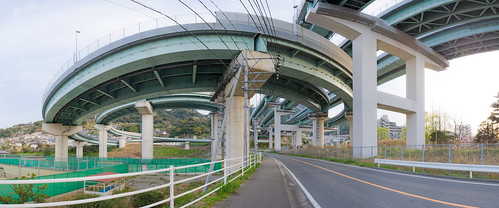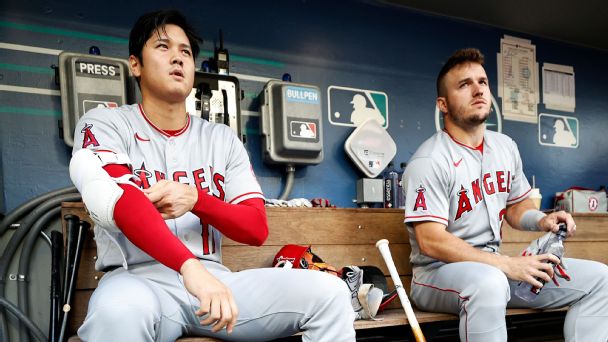Passan: Ohtani’s magic season cut short by injury
Ohtani #Ohtani

Jeff Passan, ESPNAug 24, 2023, 09:00 AM ET
CloseESPN MLB insiderAuthor of “The Arm: Inside the Billion-Dollar Mystery of the Most Valuable Commodity in Sports”
Every minute of the past three years Shohei Ohtani spent on the baseball field was a gift. The most perfect ball-playing specimen ever to wear a uniform, simultaneously one of the best hitters and pitchers in a sport that for a century had demanded players choose one track or the other, Ohtani recalibrated what the game could be. He was baseball at its zenith. He is baseball, period.
What everyone took for granted, as he launched majestic home runs and unfurled unfair pitches, was the Faustian bargain underpinning it all — that as Ohtani trafficked in the impossible, he was relying on a wholly imperfect vessel to deliver it. Ohtani’s most formidable opponent was never the pitchers or hitters he faced. It was his body and its capacity to withstand everything he asked of it. Ligaments do not care about legend.
Editor’s Picks
2 Related
Ohtani being Ohtani, he reacted to the news that he had suffered a tear in the ulnar collateral ligament of his right elbow in Game 1 of a doubleheader Wednesday by batting second for his Los Angeles Angels in Game 2. Ohtani will not pitch again this season. He might need another Tommy John surgery. His already-complicated free agency, just two months away, is now even more confusing. And Ohtani knew all of it in the second game, which, in hindsight, makes a moment that looked so wholesome at the time so heartbreaking now.
In the fifth inning, Ohtani doubled — you can still swing the bat with a UCL tear — and awaiting him at second base stood Cincinnati shortstop Elly De La Cruz, a 6-foot-5, switch-hitting, homer-crushing, 21-year-old rookie wunderkind who also happens to be the fastest man in baseball. A full-blown unicorn. And even to him Ohtani is something different altogether. To introduce himself, De La Cruz extended his right index finger and poked 29-year-old Ohtani on the arm five times, chuckling, as if to say: Are you even real?
It’s the sort of question anyone who watched Ohtani asked constantly. And Wednesday’s lesson was that he’s all too real — not a baseball automaton sent from the future to transfix but flesh and blood. Like any ballplayer, always one pitch, one swing, one stride away from a muscle or tendon or bone or ligament failing. Ohtani took on more than any other player: starting for the Angels once a week and serving as their designated hitter nightly. The job and its level of stress chipped away, little by little. And even then, Ohtani never accepted training at a reduced rate to give himself a break. Why would he? The work got him to this place.
And what a place it was. His native Japan served as the petri dish for Ohtani’s two-way experiment, and almost immediately upon his arrival to Major League Baseball as a 23-year-old in 2018, he cut a transcendent figure, his bat an awfully good sidekick to his vaunted arm. Then his UCL gave out that first season, and rehab didn’t heal it. The subsequent Tommy John surgery in October 2018 kept him off the mound in 2019 and might as well have in 2020.
It’s not that his return to form in 2021 was surprising — because to be surprised by Ohtani is a user error — but it was glorious. It could be done for a full season: 46 home runs in 155 games played, 130⅓ innings of 3.18 ERA ball over 23 starts, one unanimous American League MVP Award. And then, he showed it could be done two seasons in a row, with 2022 a little worse at the plate, a little better on the mound, undeniably MVP-worthy if not for Aaron Judge.
And now this year. Even by Ohtani’s standards it has been singular. He has been the best hitter in baseball, leading the big leagues in home runs (44), triples (7), OPS (1.069) and total bases (310). He has held opposing hitters to a .184 batting average, the lowest of all 146 pitchers who have thrown at least 70 innings. He entered 2023 with prospective suitors wondering whether he’d live up to earning the first $500 million free agent contract in baseball history, and by the middle of the season, a half-a-billion-dollar bid was liable to get a team laughed out of the room.
Perhaps the most fully formed version of Ohtani was the one we saw this spring: captain of World Baseball Classic-winning Team Japan, capper of the tournament with a strikeout of his friend and Angels teammate Mike Trout. It was a moment upon which baseball fans can reflect, perhaps wistfully, fearful that peak Ohtani has passed. It’s possible. Age is undefeated. The greatest predictor of a future arm injury is a past arm injury. Nobody, not even Ohtani, can avoid all aphorisms.
Now come questions. How bad is the tear? Will Ohtani try platelet-rich plasma again in an attempt to heal it, or is surgery a fait accompli? Regardless of Ohtani’s approach to fixing his elbow, he might not miss games for long. In 2019, seven months after surgery, Ohtani returned to DH full time as he did his Tommy John rehab for pitching. Back then, doctors considered it safe. But the demand on Ohtani’s arm far exceeds that of the typical hitter, and a second procedure leaves the elbow that much more fragile. The discussion on what’s best for Ohtani’s future will come into focus in the coming days as the Angels wind toward another playoff-free season and the expiration of his contract.
‘A decade of disaster’
As Shohei Ohtani’s free agency looms, Arte Moreno’s Angels are at a crossroads. Alden Gonzalez »
What the injury means for his future as a pitcher is bound to play a part in his free agency. The failure rate is overwhelming for players who have undergone the Tommy John procedure twice in a five-year span: Jameson Taillon, the most successful, returned and signed a four-year, $68 million free agent contract this winter. Daniel Hudson closed out a World Series. Drew Rasmussen grew into an elite starter — only to blow out a third time. Cole Ragans, a wildly talented 25-year-old, is looking the part for Kansas City but hasn’t thrown even 100 big league innings.
Of course, Ohtani does the things others can’t. He is not an outlier. He is the outlier. If he wants to be a starter again, he will be a starter again. He has earned that, and if one team doesn’t concur, Ohtani will find another that does. Because as much as the ligament tear muddies the valuation on Ohtani, whatever team is lucky enough to land him will get the biggest star in the game since Ken Griffey Jr., regardless of how many pitches he throws again. The past three years vaulted Ohtani to that rarefied place few baseball players go. He is, a century later, in achievement and prestige, Babe Ruth. And in talent, Ruth pales to Ohtani.
Ruth, remember, never played every day and pitched full time. He didn’t think it possible. Ohtani proved it so, hefty though the cost might have been. “It is a wonder he held up this long,” a person familiar with Ohtani’s routine said early Thursday morning, after the announcement of Ohtani’s UCL tear from Angels general manager Perry Minasian sent an off-hours thunderclap through the sport. The chatter was all the same, more or less. Why him? Why now? Why at all?
Totally fair questions all, but their implication — their negativity — didn’t seem to be of interest to the one person who had the right to ask them. If you really want to know who Shohei Ohtani is, and what he’s made of, look at his reaction when De La Cruz poked him. He could’ve turtled away, glowered, snapped, and he would’ve been well within his right to do any considering what he was now facing. Instead, Ohtani smiled and returned the compliment, marveling at De La Cruz’s incredible talent — a kid from Japan and a kid from the Dominican Republic conversant in the language that binds them: baseball.
Optimism is Ohtani’s choice. The last time he was at this juncture, he returned and evolved into the greatest baseball player anyone has seen. Doubt him at your peril.